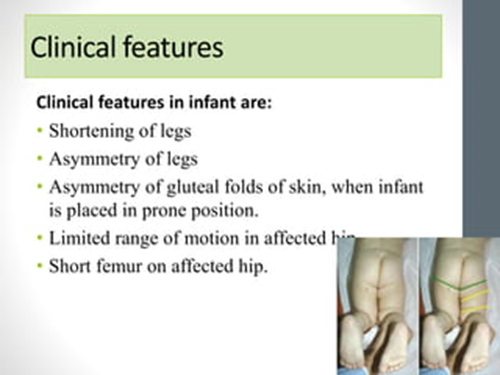A nurse is collecting data from an infant who has developmental dysplasia of the hip (DDH). Which of the following findings should the nurse expect?
Inwardly turned foot on the affected side
Lengthened thigh on the affected side
Absent plantar reflexes
Asymmetric thigh folds
Correct Answer : A,D
A. Inwardly turned foot on the affected side.
This finding is consistent with DDH. In infants with DDH, the affected leg may appear shortened and rotated inwardly due to hip instability or dislocation.
B. Lengthened thigh on the affected side.
This finding is not typically associated with DDH. In fact, the affected thigh may appear shortened rather than lengthened due to abnormal positioning of the hip joint.
C. Absent plantar reflexes.
Absent plantar reflexes are not directly related to DDH. Plantar reflexes assess the function of the spinal nerves in the lower extremities and are not typically affected by hip dysplasia.
D. Asymmetric thigh folds.
This finding is consistent with DDH. Asymmetric thigh folds, where one thigh appears fuller or has more skin folds compared to the other, can be indicative of hip dysplasia. The skin folds may be more prominent on the unaffected side due to the displacement of the femoral head on the affected side.

Nursing Test Bank
Naxlex Comprehensive Predictor Exams
Related Questions
Correct Answer is ["A","D"]
Explanation
A. Inwardly turned foot on the affected side.
This finding is consistent with DDH. In infants with DDH, the affected leg may appear shortened and rotated inwardly due to hip instability or dislocation.
B. Lengthened thigh on the affected side.
This finding is not typically associated with DDH. In fact, the affected thigh may appear shortened rather than lengthened due to abnormal positioning of the hip joint.
C. Absent plantar reflexes.
Absent plantar reflexes are not directly related to DDH. Plantar reflexes assess the function of the spinal nerves in the lower extremities and are not typically affected by hip dysplasia.
D. Asymmetric thigh folds.
This finding is consistent with DDH. Asymmetric thigh folds, where one thigh appears fuller or has more skin folds compared to the other, can be indicative of hip dysplasia. The skin folds may be more prominent on the unaffected side due to the displacement of the femoral head on the affected side.

Correct Answer is C
Explanation
A. Administer the medication at mealtime.Ferrous sulfate is best absorbed on an empty stomach because food, especially those rich in calcium or tannins, can interfere with its absorption. Administering it with meals reduces its effectiveness.
B.While bedtime administration is not contraindicated, it is not necessary. The timing of administration should focus on maximizing absorption, typically between meals or on an empty stomach.
C. Ferrous sulfate can stain teeth if taken orally in liquid form. Using a straw minimizes contact with teeth, reducing the risk of discoloration. Parents should also be advised to encourage the child to rinse their mouth after taking the medication.
D. Dilute the medication with 240 mL of milk. Milk contains calcium, which inhibits the absorption of iron. Ferrous sulfate should not be taken with milk or dairy products to ensure optimal absorption.

Whether you are a student looking to ace your exams or a practicing nurse seeking to enhance your expertise , our nursing education contents will empower you with the confidence and competence to make a difference in the lives of patients and become a respected leader in the healthcare field.
Visit Naxlex, invest in your future and unlock endless possibilities with our unparalleled nursing education contents today
Report Wrong Answer on the Current Question
Do you disagree with the answer? If yes, what is your expected answer? Explain.
Kindly be descriptive with the issue you are facing.
